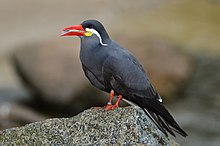User:Gemizzle/sandbox
| Gemizzle/sandbox | |
|---|---|

| |
| Inca tern at Walsrode Bird Park, Germany, eating a fish | |
| Scientific classification | |
| Domain: | Eukaryota |
| Kingdom: | Animalia |
| Phylum: | Chordata |
| Class: | Aves |
| Order: | Charadriiformes |
| Family: | Laridae |
| Genus: | Larosterna Blyth, 1852 |
| Species: | L. inca
|
| Binomial name | |
| Larosterna inca (Lesson, 1827)
| |
The Inca tern (Larosterna inca) is a tern in the family Laridae. It is the only member of the genus Larosterna.
This uniquely plumaged bird breeds on the coasts of Peru and Chile, and is restricted to the Humboldt Current. It is an erratic, rare visitor to the southwest coast of Ecuador.
Description[edit]

The Inca tern is a large tern, approximately 40 cm (16 in) long, weighing 180-210g . They have a life span of 14-20 years. Sexes are similar; the adult is mostly slate-grey with white restricted to the facial plumes and the trailing edges of the wings. The large bill and legs are dark red. Immature birds are purple-brown and gradually develop the facial plumes as they reach adolescence.
Behaviour[edit]
The Inca tern likes nesting and living in large communities of birds, sometimes with several thousands of birds.[2] It has a distinct, cat-like 'mewing' call.[2]
Breeding[edit]
The Inca tern breeds on rocky cliffs. The Inca tern displays shows of courtship before it mates. In order to impress the female, the male Inca tern displays its agile flight and sometimes flies after the female with a fish in his bill.[3] The Inca tern breeds up to two times per year, generally between the months of April to July and October to December.[2]It nests in a hollow or burrow or sometimes the old nest of a Humboldt penguin, and lays one or two eggs. Inca terns like to keep their nest hidden, usually in guano islands or beaches, where they hide their nests in crevices and cliffs.[3] They can also nest in abandoned buildings and beach huts.[4] The eggs are incubated by both their mother and father for about four weeks, and the chicks leave the nest after seven weeks.[5]
Diet[edit]
The Inca tern feeds primarily on small fish, such as anchovies, mostly found in the south-east of the Pacific Ocean, as well as crustaceans and offal.[2] The Inca tern also has been known to steal food from some marine mammals, such as whales and sea lions.[2] The species spots its prey from the air, diving into the water to grab meals with its pointed beak.[5]
Population[edit]
The Inca tern's population is steadily decreasing.[4] Their numbers are affected by environmental factors like El Niño and overfishing, reducing the amount of food available for the Inca terns to eat and displacing them in large numbers.[3] Rats and/or cats near Inca terns' nests may also reduce nesting or breeding numbers.[4] Their current conservation status is Near Threatened.[4]
References
- ^ "Larosterna inca". IUCN Red List of Threatened Species. 2013.2. 2012. 2012.
{{cite journal}}:|access-date=requires|url=(help); Unknown parameter|assessor-link=ignored (help); Unknown parameter|assessor=ignored (help) - ^ a b c d e http://www.oiseaux-birds.com/card-inca-tern.html
- ^ a b c "Inca Tern - Facts, Diet, Habitat & Pictures on Animalia.bio". animalia.bio. Retrieved 2018-02-08.
- ^ a b c d "Larosterna inca (Inca Tern)". www.iucnredlist.org. Retrieved 2018-02-14.
- ^ a b "Inca Tern Fact Sheet, Lincoln Park Zoo"
- Harrison, Peter (1988): Seabirds (2nd edition). Christopher Helm, London ISBN 0-7470-1410-8
External links[edit]
Inca tern
Inca tern
Category:Birds of Peru
Category:Birds of Chile
Category:Western South American coastal birds
Inca tern


